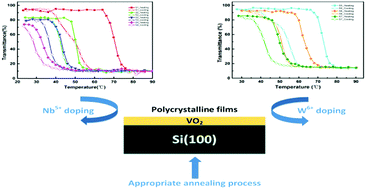Optimization of metal-to-insulator phase transition properties in polycrystalline VO2 films for terahertz modulation applications by doping†
Abstract
Vanadium dioxide (VO2), due to its well-known metal–insulator phase transition (MIT), is a promising candidate to realize optical modulation devices operating at terahertz (THz) frequencies. Moreover, the application of VO2 on modulation devices requires a narrow hysteresis width associated with a significant change in its optical properties, which is quite challenging in Si-based polycrystalline VO2 films. In this paper, by doping high-valence metal ions (W6+ or Nb5+) into polycrystalline VO2 films, a narrowed hysteresis width and a decreased phase transition temperature are observed. Intriguingly, these doped VO2 films always maintain a high THz field modulation depth despite the low phase transition temperature resulting from the usage of either W or Nb dopants. To sum up, the optimized VO2 film with 6.5% Nb doping deposited on high-purity silicon substrates exhibits the best MIT characteristics with a giant field THz modulation depth of 62.5%, a small hysteresis width down to 4.8 °C and a low phase transition temperature of around 31.1 °C, which is very excellent for practical applications. Furthermore, we synthetically investigate the influences of W and Nb doping on the microstructures and MIT characteristics of the polycrystalline VO2 films. Doping Nb5+ and W6+ ions has similar effects through a similar mechanism. In addition, the excellent balance between the THz modulation ability and phase transition temperature is related to the high crystallinity degree of the doped films. The annealing process may play a key role in this peculiar case. These results show that the excellent MIT properties of the polycrystalline VO2 films can be effectively tailored by our distinctive preparation method, which provides a feasible solution to the design and fabrication of VO2 films with suitable MIT properties for THz devices.



 Please wait while we load your content...
Please wait while we load your content...